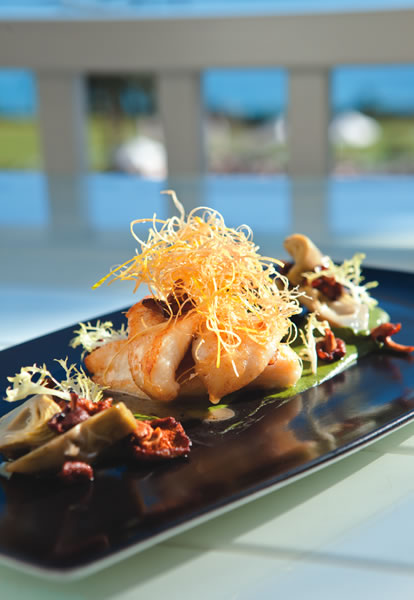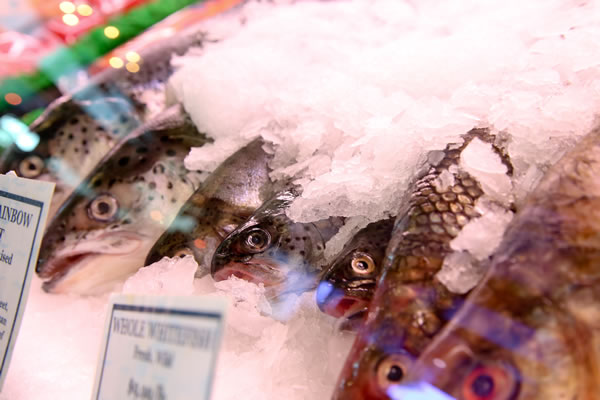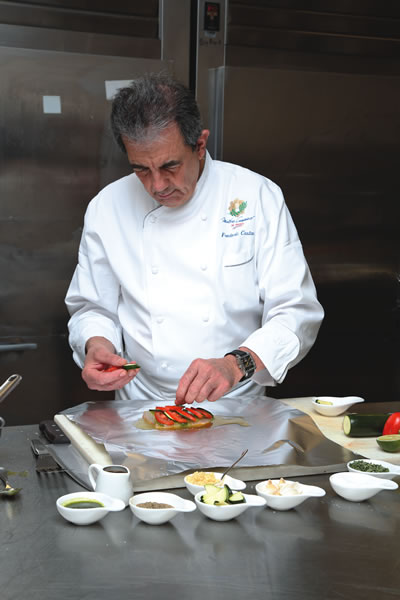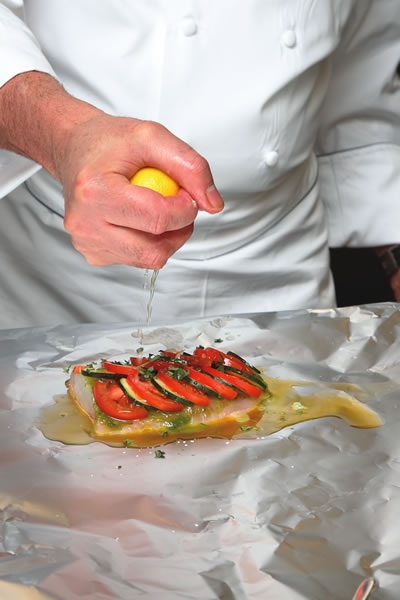Local chefs turn to the ocean for fresh ingredients used in delectable seafood dishes.
By Rich Manning
 For some parts of the country, terms like “fresh” and “purveyor” are buzzwords attached to a white-hot, nationwide restaurant trend. Yet for Laguna Beach, they represent a way of life that was part of the dining scene long before the term “farm-to-table” was successfully marketed. And one of the best representations of this standard can be seen in the city’s take on coastal cuisine. It stands to reason that fresh seafood would be such an important player on Laguna’s culinary landscape—after all, the Pacific Ocean makes up the city’s undulating southern border.
For some parts of the country, terms like “fresh” and “purveyor” are buzzwords attached to a white-hot, nationwide restaurant trend. Yet for Laguna Beach, they represent a way of life that was part of the dining scene long before the term “farm-to-table” was successfully marketed. And one of the best representations of this standard can be seen in the city’s take on coastal cuisine. It stands to reason that fresh seafood would be such an important player on Laguna’s culinary landscape—after all, the Pacific Ocean makes up the city’s undulating southern border.
“The diverse marine ecosystem in this part of California provides us with a plethora of interesting proteins from the Pacific,” explains Marc Cohen, executive chef and owner of Watermarc. “This list includes locally caught halibut, Santa Barbara sea bass, mussels, oysters and spiny lobsters, to name a few.”
Plus, Southern California’s geography and climate, both on the sea and the land, certainly provide chefs with a singular mix of aquatic ingredients to utilize. What’s more, when these ingredients are put in the hands of Laguna Beach’s top culinary masters, their beauty is heightened even further.
On the Menu
This coming spring, Laguna’s chefs are poised to create dishes with a creative reach that seems almost as wide as the Pacific Ocean itself. When it comes time to sit down and create a seafood-centric dish, specific motifs keep cropping up amongst the chefs: fresh ingredients and simple preparation—seafood must be the star of the plate.
“The ingredient is at the forefront whether it is from the surf or the turf,” says Casey Overton, chef de cuisine at The Loft at Montage Laguna Beach.
In the springtime, Casey likes to surround his seafood with herbaceous accents and seasonal flavors like pea tendrils and spring flowers. One of his favorite springtime seafood dishes is a pan-seared John Dory paired with spring garlic, artichoke puree, golden chanterelle mushrooms and barigoule butter. While the supporting elements add depth, each ingredient ultimately acts as a conduit meant to point the taste buds directly at the dish’s main component.
“Seafood is easy to be creative with because it gives you sort of a blank canvas,” explains Michael Ingino, executive chef of The Deck in Laguna Beach. “The ways you can utilize a piece of quality seafood in a dish practically seems endless to me.”
On the seasonal menu at The Deck this spring, Michael will feature Alaskan halibut, which he plans to saute and then finish in the oven. To draw out the natural flavors, he’ll pair the fish with Carlsbad clams, chorizo and potatoes; these components will all be sauteed in a separate pan and finished with white wine saffron and a touch of butter.
Marissa Gerlach, executive chef at Raya at The Ritz-Carlton, Laguna Niguel, says that her signature dish of the season includes a plate of yellow mole mussels and clams with roasted garlic on toasted ciabatta, as well as a coconut lobster bisque with lemongrass, chilies, black garlic and Thai basil.
“The seasonal nature of seafood also means that this creative process constantly reinvents itself,” she explains. “Seafood is a good base for me to … create something new and different.”
At Watermarc, chef Marc will be giving Copper River salmon a starring role. “It has a deep belly fat and it melts in your mouth,” he says. One of the more memorable ways he has shared the fish’s mouthwatering soluble properties with diners is by grilling it atop a pair of cedar planks soaked in a marinade of Jack Daniel’s whiskey and other ingredients for 48 hours. He brushes the fish with mustard and brown sugar before being finished in the oven.
While the featured ingredients are different, the dishes that will be produced at local restaurants are designed to fully tap into Laguna’s springtime vibe.
Lemon-Glazed Pacific Halibut
Serves 4
4 pieces of 6-ounce center-cut pacific halibut
Sea salt and white pepper, to taste
3 ounces canola oil
2 ounces cooking white wine
1 whole lemon, squeezed
3 ounces whole European-style butter
½ ounce fresh thyme, chopped
½ ounce fresh parsley, chopped
Method: Dry the halibut by patting it with a paper towel. Season on all sides with salt and white pepper. Pour canola oil into a nonstick pan and preheat to a smoking point. Once the oil begins to smoke, place fish on the pan and sear at medium-high heat until the bottom edges begin to turn golden brown (lift fish with a large spatula and look for a golden brown crust).
Flip the fish over and turn the heat to medium-low. After cooking for about a minute, add the white wine to deglaze followed by the lemon juice.
Add butter, thyme and parsley and baste the fish until it is cooked and glazed (insert a metal skewer into the halibut for 10 seconds and touch the skewer to your hand—it should be warm). Serve immediately.
(Recipe from Pedro Contreras, executive chef at The Ritz-Carlton, Laguna Niguel)
A good piece of seafood doesn’t need much help to be transformed into a mouthwatering dish. This notion has just as much merit at home as it does in the kitchens of some of Laguna Beach’s top restaurants. Home cooks, however, may feel apprehensive at the intimidating task of preparing fish on their own. It’s an anxiety that seems more heightened in dealing with seafood as opposed to other meats, since information relating to its preparation can remain as mysterious as the ocean’s inky depths.
Fortunately, the answers to even the toughest questions are, in reality, not all that complex. First and foremost, even before you set foot into the kitchen, the product that you buy should be as fresh and high quality as possible. To ensure this, don’t be afraid to circumvent the grocery store and find other places to do your seafood shopping, such as a specialty store.
“For home preparation, I go up to Costa Mesa and stop by Santa Monica Seafood,” Michael says. “They always have great seafood available.”
“When buying fresh fish to cook at home, I go to the farmers market,” Marissa adds. “There are always one to two small local fish farms, companies or purveyors that have whatever was harvested that morning on hand.”
Pay close attention to the firmness of the flesh when shopping, as well as the odor, as these are areas that can help identify fresh catches. Fresh fish should be firm and have a subtle sea aroma—not a strong odor, which can indicate that it’s been sitting in a display case for some time. Bringing a cooler along while shopping can help keep the fish chilled on your drive home. Most importantly, don’t be afraid to ask questions—most markets have staff that can offer insight into quality or freshness.
While it can take some legwork to get the best seafood possible, this may be the most difficult step of the process. If anything, the key to preparing healthy, naturally flavorful seafood is to keep things as uncomplicated as possible. Doing so will allow the flavor of the seafood to shine through prominently.
“I like to keep it simple when I’m preparing seafood at home,” Michael says. “I just use fresh black pepper and some sea salt, and simply grill or sauté the fish.”
Of course, that doesn’t mean you can’t be adventurous and take a culinary detour. Indeed, you can deviate off the path a by adding a few accents to enhance your seafood’s flavor profile. Rather than drowning the seafood in a deluge of sauces or secondary ingredients, add a pinch of spice or touch of herbs to create a sense of depth in the dish. In some cases, it may even add a little exotic flair.
“I like to use achiote paste,” Marissa says. “It’s a spice that is grown in Mexico and throughout South America. I’ll blend it up with garlic and orange juice, smear it over the fish and broil it until I get a little bit of a char on top.”
Ultimately, when it comes to seafood in Laguna Beach, it doesn’t necessarily matter if it’s professionally and artfully prepared at a local restaurant or enjoyed in the comfort of your home. What truly counts is making sure the integrity of the seafood is maintained throughout the process. This level of respect is achieved not only through purchasing high-quality seafood from a trusted, reliable source, but also by allowing it to shine on its own tasty merit.
“Seafood is about quality and freshness,” Marc says. “An old and very well-decorated chef once told me, ‘It’s not about what you do to the highest-quality seafood … it’s what you don’t.’ ” LBM
By Micaela Myers
Frédéric Castan, executive chef at The St. Regis Monarch Beach, shares a surefire method for easily preparing delicious and healthy seafood. “What I do at my house is I take aluminum foil, and I put some olive oil on the bottom,” he explains. “I take a piece of salmon or bass. I salt and pepper both sides.” For an Asian flavor, he adds a bit of ginger, olive oil or a stream of sesame oil, plus lemon juice. “If I don’t want to use salt, I’ll use a few drops of soy sauce,” chef Frédéric says. “Then I fold the aluminum foil three times all the way around the fish to enclose the fish tight.” Once the fish is seasoned and wrapped, cook at 350 degrees for 10 – 17 minutes (depending on the thickness of the fish). “When I open that bag, all the juice is there and it’s not overcooked,” he explains. “Then I can finish it with a little bit of soy sauce if I want.”
You can play with this simple preparation method by mixing up the seasonings. Use herbs like basil and thyme with garlic—maybe even add a slide of tomato on top. “You can process those herbs and garlic together in the food processor and put that on the bottom,” the chef says. Add olive oil, salt and pepper to the top, as well as lemon juice. The result is moist, flavorful fish every time.









